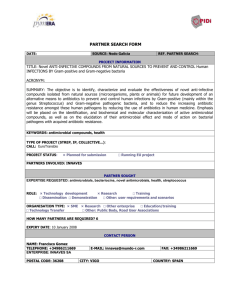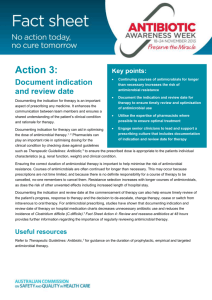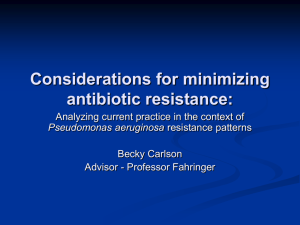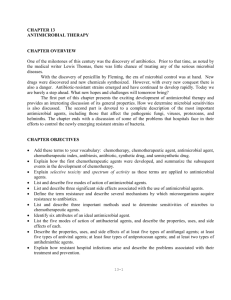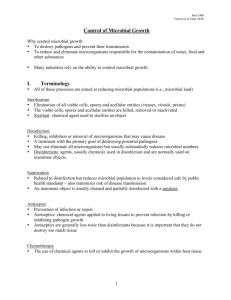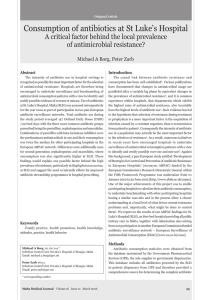PBL2 Antibiotic Choice - Ipswich-Year2-Med-PBL-Gp-2
advertisement
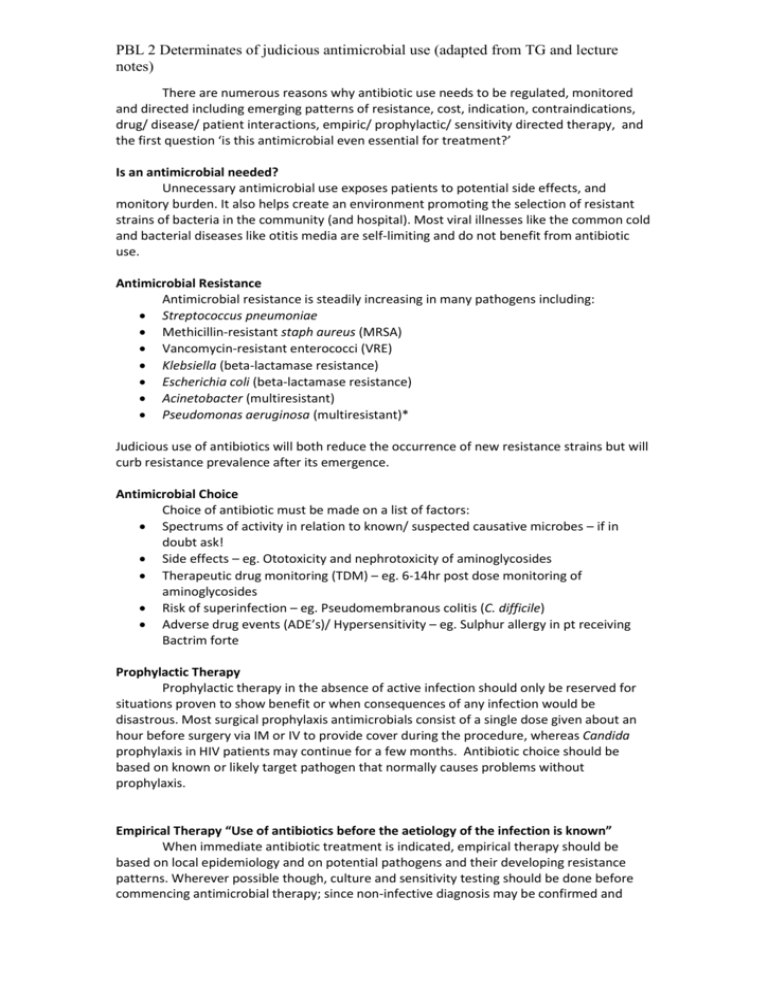
PBL 2 Determinates of judicious antimicrobial use (adapted from TG and lecture notes) There are numerous reasons why antibiotic use needs to be regulated, monitored and directed including emerging patterns of resistance, cost, indication, contraindications, drug/ disease/ patient interactions, empiric/ prophylactic/ sensitivity directed therapy, and the first question ‘is this antimicrobial even essential for treatment?’ Is an antimicrobial needed? Unnecessary antimicrobial use exposes patients to potential side effects, and monitory burden. It also helps create an environment promoting the selection of resistant strains of bacteria in the community (and hospital). Most viral illnesses like the common cold and bacterial diseases like otitis media are self-limiting and do not benefit from antibiotic use. Antimicrobial Resistance Antimicrobial resistance is steadily increasing in many pathogens including: Streptococcus pneumoniae Methicillin-resistant staph aureus (MRSA) Vancomycin-resistant enterococci (VRE) Klebsiella (beta-lactamase resistance) Escherichia coli (beta-lactamase resistance) Acinetobacter (multiresistant) Pseudomonas aeruginosa (multiresistant)* Judicious use of antibiotics will both reduce the occurrence of new resistance strains but will curb resistance prevalence after its emergence. Antimicrobial Choice Choice of antibiotic must be made on a list of factors: Spectrums of activity in relation to known/ suspected causative microbes – if in doubt ask! Side effects – eg. Ototoxicity and nephrotoxicity of aminoglycosides Therapeutic drug monitoring (TDM) – eg. 6-14hr post dose monitoring of aminoglycosides Risk of superinfection – eg. Pseudomembranous colitis (C. difficile) Adverse drug events (ADE’s)/ Hypersensitivity – eg. Sulphur allergy in pt receiving Bactrim forte Prophylactic Therapy Prophylactic therapy in the absence of active infection should only be reserved for situations proven to show benefit or when consequences of any infection would be disastrous. Most surgical prophylaxis antimicrobials consist of a single dose given about an hour before surgery via IM or IV to provide cover during the procedure, whereas Candida prophylaxis in HIV patients may continue for a few months. Antibiotic choice should be based on known or likely target pathogen that normally causes problems without prophylaxis. Empirical Therapy “Use of antibiotics before the aetiology of the infection is known” When immediate antibiotic treatment is indicated, empirical therapy should be based on local epidemiology and on potential pathogens and their developing resistance patterns. Wherever possible though, culture and sensitivity testing should be done before commencing antimicrobial therapy; since non-infective diagnosis may be confirmed and PBL 2 Determinates of judicious antimicrobial use (adapted from TG and lecture notes) monitory and resistance costs reduced, or in the case of unestablished infective cause, continue therapy for more than 48 hours. (eg. Trimethoprim for UTI, ceftriaxone for bacterial meningitis etc) Directed Therapy When culture and sensitivity results come back from pathology and the results give some antibiotic choices, it is important to acknowledge that organisms isolated may not necessarily be responsible for the clinical picture. To reduce risk of superinfection with resistant micro-organisms, the chosen antimicrobial should be the: Most effective Least toxic Narrowest spectrum Most cost effective Directed therapy can be sensitivity directed or pathogen directed. Pathogen directed therapy is a less accurate way to prescribe since need to consider Likely antibiotic resistance profile in that particular patient What antibiotics has the patient recently received? What resistant organisms have been cultured from the patient previously? Likely resistance profile in that particular geographic area or ICU Topical Therapy Topical antibiotic therapy should be restricted to a few conditions proven to benefit (eg. Conjunctivitis) and should be from different antibiotic classes than those used for systemic therapy. Combination Therapy Generally speaking, only use combinations for antimicrobials to: Extend the spectrum (eg. mixed infections like PID) Achieve synergy that is known to improve outcomes (eg. enterococcal endocarditis with gent and amoxy or H.pylori with clarithromycin and amoxy) Prevent emergence of resistant strains (eg. TB treatment) Duration of Therapy To minimise resistance and development of drug adverse effects, it is important to limit duration of therapy. Some infections have well documented timelines, while others rely on clinical signs to guide duration. Duration of therapy also depends on what kind of killing type the antimicrobial exhibits: •Concentration dependent (eg. Aminoglycosides and Quinolones) –Maximal killing at maximal concentrations –Upper concentration limit is the concentration that will produce toxicity Note: it is better to give a 7mg/kg once daily dose of gentamicin for 3 days than to give a 3.5mg/kg once daily dose for a week; since killing is concentration dependent, and ototoxicity and nephrotoxicity are related to total AUC and not concentration so the longer the time on gent the higher the risk of side effects. So shorter duration of therapy reduces side effects and resistance and increases bacterial kill BUT Dr’s are still so scared of dosing gentamicin correctly!!! Aargh! •Time dependent (Penicillins and Cephalosporins) –Do not get greater killing at high concentrations –Time above MIC is the important consideration
![Professor Anthony Kessel, Director of Public Health Strategy, Health Protection Agency [PPT 10.39MB]](http://s2.studylib.net/store/data/015100065_1-52ef62fa093dba928ff11f1845be5aa1-300x300.png)


